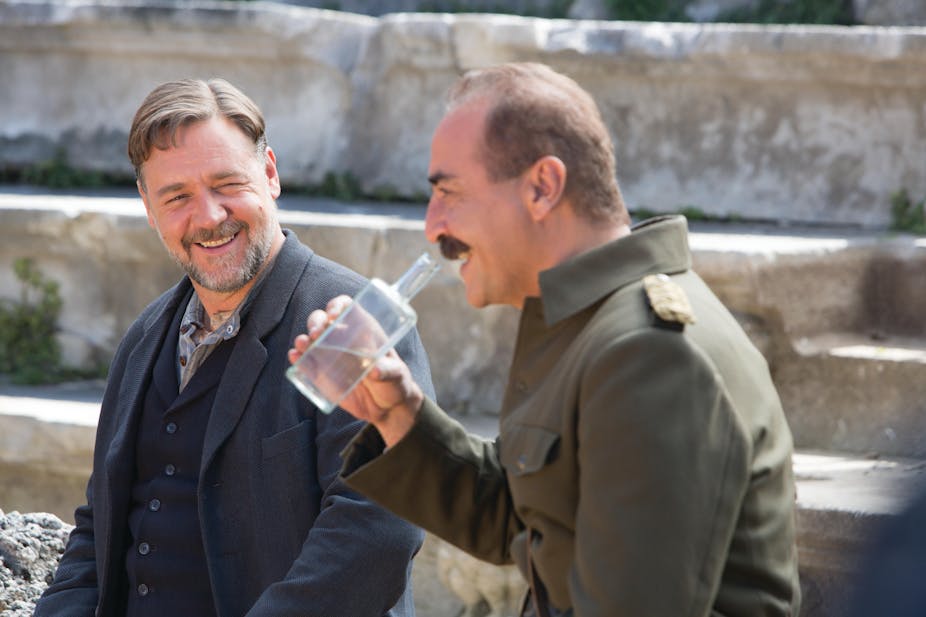For movies “inspired by actual events”, even the most inconsequential historical mistakes can raise rebuke. So it is with Russell Crowe’s 2014 directorial debut, The Water Diviner.
The plot takes its cues from the Allied invasion of the Gallipoli peninsula in 1915 and follows an Australian farmer, Joshua Connor (played by Crowe), in post-first world war Turkey searching for his three sons reportedly killed in action. Buoyed by the impending centenary of the Gallipoli campaign, the film has notably achieved critical and commercial success in film circles.
But those who are more concerned with The Water Diviner’s historical accuracy, rather than its artistic or entertainment value, have been less enthusiastic. Emblematic of this response is historian Peter Stanley’s review of the film in Honest History.
Stanley finds the picture “fundamentally silly”, arguing that Crowe and his screenplay writers, Andrew Knight and Andrew Anastasios, “[portray] several aspects of the Great War and its aftermath in highly-coloured or misleading ways”. Other commentators have criticised the film for its omissions, notably its failure to address the Armenian Genocide.

We don’t want to build on this criticism – nor to diminish it. Instead, we want to highlight how The Water Diviner might open doors to conversations about alternate narratives of Gallipoli, Anzac and the first world war.
Historians alive to the dangers of “Anzackery” – used to describe Australia’s obsession with the Anzac Legend – have good reason to bring The Water Diviner’s many factual blunders to the attention of film-goers. When it comes to depicting the Dardanelles Campaign with historical veracity, Australian filmmakers have a chequered record.
Peter Weir’s 1980 Gallipoli, which embroidered the Anzac Legend, perhaps remains “the most influential representation of Anzac in recent times”, in the words of historian Daniel Reynaud. The danger lies in the poetic licence used in Gallipoli and The Water Diviner being regarded as “historical truth” by the general public.

While Crowe’s take on Gallipoli and its aftermath cannot possibly replace informed historical inquiry, it does represent an important shift in how the campaign is presented on the silver screen. Its capacity for changing popular understandings of Gallipoli and Anzac cannot be easily dismissed.
This article is not the first to suggest The Water Diviner subverts Anzac mythology. Writing in Honest History, David Stephens does a good job of summarising the film’s capacity to reveal the horrors of the first world war. Elucidating on what facts The Water Diviner gets right would tread ground already covered by others, but it is worth briefly pointing to how film-goers might have their historical imaginations broadened.

The film depicts the central protagonist’s view of the campaign shifting from a narrow Australian perspective to something more holistic and transnational. This shift is revealed in an exchange between a Turkish army officer and Crowe’s character that raises the vital issue of death statistics for the Gallipoli Campaign (the Turkish forces suffered greater casualties than the Anzacs).
Viewers are alerted to the fact that there were Australian prisoners of war in the Ottoman Empire. Audiences, too, are given clues to the fighting that continued to ravage parts of Europe in the immediate years following the first world war through allusions to the Greco-Turkish War 1919-22.
In so doing, the film shows how messy and fractured this part of Europe was in the aftermath of the war.
The keying into the Turkish perspective is perhaps evidence of Turkish filmmaker Tolga Örnek’s involvement in the script and the book. Örnek directed Gallipoli: The Frontline Experience (2005), one of the only international documentaries on the campaign and a powerful anti-war statement.
Despite the questionable accuracy of some of The Water Diviner’s historical depictions, certain material around its making underlines its potential for perspective shifting. In particular, the widespread accessibility to Crowe’s interviews and his experiential insight is important to consider here.

Crowe’s personal story about making The Water Diviner raises the point that the Turkish and Greek people know Gallipoli alternatively as Gelibolu or Kallipoli, meaning “beautiful city” (in Greek). That Crowe is prepared to confess that he personally felt ashamed about how little he knew about the Turkish experience is significant. Many online comments on his various interviews point to similar revelations among the general public.
For historians alarmed by the militarisation of Australian history and politics over 2014-18, Crowe is a well-known face reaching a wider audience than most historians can ever hope to. Furthermore, that Crowe’s standpoint on Gallipoli changed during the making of the film shows that personal stories can act as an access point to engage with Australia’s first world war history.
As professional historians, the authors of this article do not want to see audiences’ historical knowledge skewed by filmic misrepresentations of the past.
But The Water Diviner should not be dismissed out-of-hand for its historical missteps. Crowe and his writers have made a significant step in the task of moving popular understandings towards something closer to the “historical truth” on Gallipoli, Anzac and the first world war; themes that are currently dominating the national calendar.
Although it does not go as far as many informed commentators would like, The Water Diviner incrementally expands the Anzac narrative.

